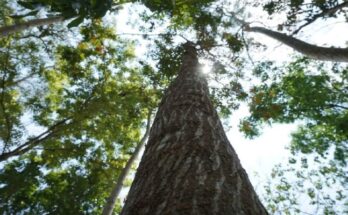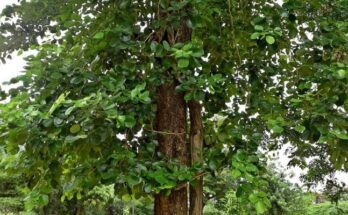|
Getting your Trinity Audio player ready...
|
Madhuca longifolia is an Indian tropical tree found primarily in the plains and forests of central, southern, and northern India, Nepal, Myanmar, and Sri Lanka. Mahua tree is 10-15m tall and with a spreading, round, dense, and shady canopy. The bark is rough, brown in color, slightly cracked, and fissured; the inner bark is red and exudes a milky white sap when cut.
Scientific Name of Mahua Tree is Madhuca Longifolia
Scientific Classification of Mahua Tree
| Classification Type | Classification Status |
|---|---|
| Kingdom | Plantae |
| Clade | Tracheophytes, Angiosperms, Eudicots, Asterids |
| Order | Ericales |
| Family | Sapotaceae |
| Genus | Madhuca |
| Species | M. longifolia |
Uses of the Mahua Tree (Madhuca Longifolia) are as follows:
- Mahua preparations eliminate intestinal worms, respiratory infections, weakness, and emaciation. The astringent bark extract is used for dental problems, rheumatism, and diabetes. Madhuca longifolia flowers seasonally produce green, fleshy fruits with three to four seeds.
- Several parts of the tree, mainly the bark, are used for their therapeutic benefits.
- Leprosy is often treated with a medicinal extract from the tree’s bark. The seed cake that remains after oil extraction is an excellent fertilizer.
- The flowers have a calming, firming, and softening effect. They treat coughs, colds, and bronchitis, among other things.
- The juicy sweet flowers can be eaten fresh or dried, powdered and baked with flour, fermented into alcohol, or used as a sweetener.
- The people of western Odisha rely heavily on the mahua fruit as their primary food source due to its non-toxic nature. The tree holds an important place in local culture. Its fruits and flowers are used to prepare a variety of delicious dishes.
Know About Mahua Tree Fruit (Madhuca Longifolia Fruit)

Mahua fruit, once common in northern and central India in summer, is now challenging to find. Although mahua flowers are known for their culinary appeal and use in making alcohol, you rarely see people selling mahua fruit, even at village bazaars. The edible part of the fruit is the mushy skin surrounding the pit. When grains are scarce in the area, a mixture of mahua flowers and sal seeds is cooked to prepare a dish that can substitute for basic grains.
Ayurvedic Health Benefits From Mahua
In the current scenario, people are running toward the beauty of things, and this plant is the perfect combination of beauty and its other uses. Its advantages are many. Its broad, shallow root system holds soil and reduces erosion.
- Bronchitis: Take dried Mahua flowers. Dust. Take a teaspoon with a glass of milk.
- Ascaris: Make a brew with Mahua bark. Drink 30 ml once a day.
- Liver congestion: Add 1/4 teaspoon of mahua bark powder to 1 cup of lukewarm water. Take it once a day.
- Biliosis: Drink 10 ml Mahua bark decoction three times a day.
- Ulcers: Boil 3 g Mahua bark in 50 ml water. Take it twice a day.
- Cardio Tonic: Take mahua flowers. Make a decoction. Drink 20 ml three times a day.
- Batteries: Fry some mahua flowers with clarified butter. Take one teaspoon twice a day.
- Expectorant: Take half a cup of Mahua flower decoction daily.
- Tuberculosis: Boil 10g of crushed mahua fruit in 100 ml of water. Drink 20 ml twice a day.
- Galactagogue: Add one teaspoon of Mahua seeds to a cup of water. Boil. If tolerable, drink once a day.
- Orchitis: Soak mahua leaves in boiling water for half an hour. Attach them to the testicles.
- Gum disease: Use mahua bark decoction as a mouthwash.
- Inadequate breast milk: Mahua helps produce more milk. You should boil 5 grams of mahua seeds in one cup of water. Print. Take warm once a day.
How to Grow Mahua Tree?
Since it is a large plant, it cannot be grown in a house with a small area. You must have an open space large enough to support the plant’s roots and branches. It is a wild plant, generally cultivated in the forest. It requires warm and humid temperatures as it is mainly grown in south-central India. One of the most important things is that it requires a significant amount of rainfall, which means these plants need watering quite often. No special fertilizer is necessary to grow this plant; only the climatic suitability of this plant has to be considered.
Know about Mahua Seeds (Madhuca Longifolia Seeds)

Mahua seeds are of economic importance as they are a good source of edible fat. The flowers are traditionally used as a refreshing, tonic, aphrodisiac, astringent, and soothing for treating helminths, acute and chronic tonsillitis, pharyngitis, and bronchitis. The leaves are expectorant and used for chronic bronchitis and Cushing’s disease. The distilled juice of the flower is considered a tonic, both nourishing and refreshing, and also in treating helminths, acute and chronic tonsillitis, and bronchitis.
Wrapping Up
The benefits of mahua flowers and other parts of the tree are immense. It can also create vast opportunities for poor farmers, tribes, and rural people in India. But due to a lack of proper post-harvest infrastructure and political will, our farmers and tribes are being forced to adopt non-native western crop species. As consumers, we can steer the market in the right direction by demanding what is local, good for our health, and suitable for the self-sufficiency of the rural economy.



